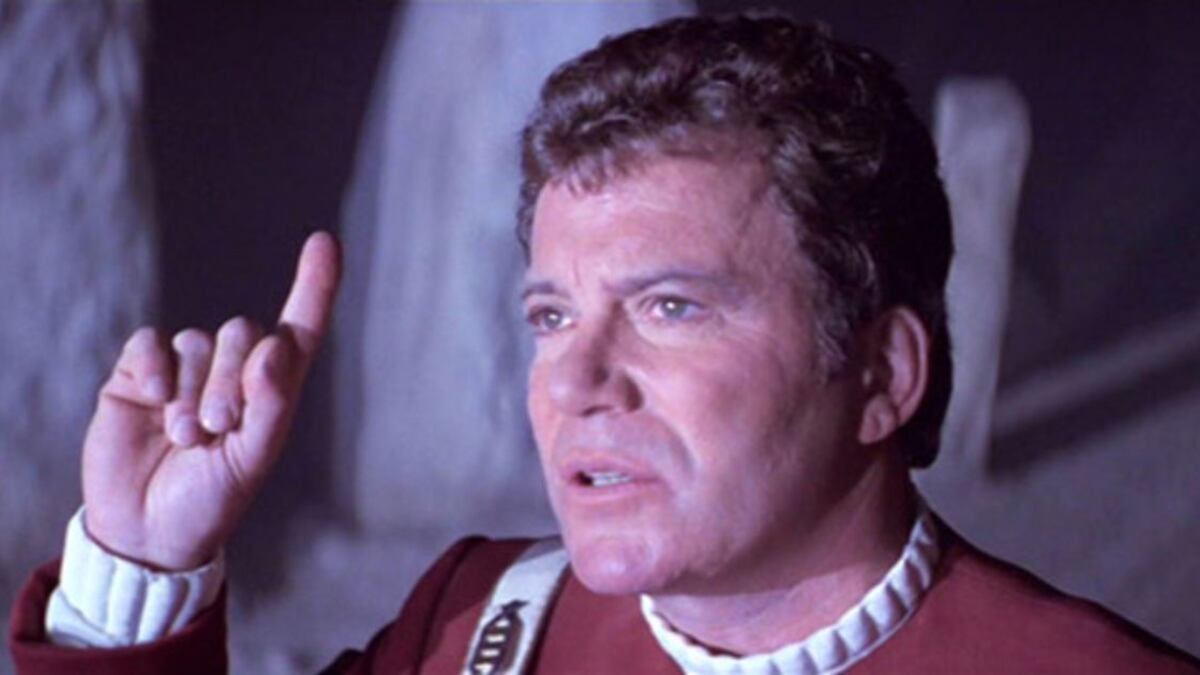“Oh my God. What are we going to do?” According to Robert Schnakenberg’s The Encyclopedia Shatnerica, that’s what George Takei said when he learned that Capt. Kirk himself, William Shatner, would be making his feature directorial debut with Star Trek V: The Final Frontier.
Takei had good reason to fear his co-star’s ascension to the director’s chair. During the original Star Trek TV series, Shatner had found numerous ways to torment his castmates, from cutting their dialogue to repeatedly stealing Leonard Nimoy’s red bicycle.
Still, it’s unlikely that any of the actors imagined the delusional heights Shatner would reach as a filmmaker. Released June 9, 1989, The Final Frontier (which screens Thursday at Hollywood Theatre) is so hokey and pretentious that it became Star Trek’s version of The Room: A hilariously self-serious dud that achieves bad-movie nirvana.
The Final Frontier pits the crew of the U.S.S. Enterprise against Sybok (Laurence Luckinbill), a holy man (and half-brother to Nimoy’s Spock) who forces Kirk to ferry him to the center of the galaxy, where he believes he will meet God (!).
Believe it or not, the premise was almost even stranger. Shatner originally wanted to suggest that both God and the devil exist in Star Trek, include a literal trip to hell, and feature Sybok (then called Zar) riding a unicorn that spears someone with its horn.
Luckily, Star Trek creator Gene Roddenberry quashed Shatner’s more outré ideas, according to Captain’s Log: William Shatner’s Personal Account of the Making of Star Trek V: The Final Frontier (in particular, Roddenberry, an atheist since he was a teenager, opposed the inclusion of any overtly religious content).
Captain’s Log was actually written by Shatner’s daughter, Lisabeth. While she wrote that her father compromised with the script’s detractors (including Nimoy, who objected to a scene where the ever-loyal Spock would have betrayed Kirk), his troubles didn’t end when the screenplay was finished.
During principal photography (which began Oct. 11, 1988), a Teamsters Union strike left the production with inexperienced drivers, costumes were stolen, film prints were damaged, and Shatner went ballistic while struggling to film the opening scene in the Mojave Desert.
“My father’s distress gradually mounted as he watched several unsuccessful attempts, until finally he exploded and started yelling,” Lisabeth wrote. “In a half-joking gesture of frustration, he even flung himself down on the ground and pounded the cracked earth. Unfortunately, his dramatic gesture didn’t solve anything.”
Just as unsettling was the decision to subject beloved characters to humiliating ordeals—including the scene where Uhura (Nichelle Nichols, who died in July) dances nearly naked to distract a group of leering Sybok followers.
In Captain’s Log, Shatner recalled conceiving the scene with screenwriter David Loughery and producer Harve Bennett. “Well, we became so unglued by the thought that I was literally on the floor laughing,” he said. “Harve was hysterical with laughter, and David was looking at us with a peculiar laugh saying, ‘All right, guys, let’s get serious.’”
The scene made it into the film with the vomit-worthy line “Hello, boys! I’ve always wanted to play to a captive audience!” On TV, Uhura broke barriers as a Black woman on relatively equal footing with a majority-white bridge crew. In The Final Frontier, she became just another victim of Shatner’s degrading humor.
Amazingly, the film survived still more creative turbulence, including a failed attempt at an action scene with a rock monster (actually a stunt man in a latex suit). But there was no salvaging Shatner’s baffling vision: The film’s final box office tally was a mediocre $52 million, down by half from Star Trek IV: The Voyage Home.
Yet for all its flaws, The Final Frontier has a peculiar charm. Thanks to its unintentionally uproarious mystical melodrama, the film at least stinks in an entertaining fashion, especially when Kirk dramatically wonders, “What does God need…with a starship?!”
In 1991, Star Trek rebounded at the movies with Star Trek VI: The Undiscovered Country. Shatner wasn’t invited back to direct (shocking!), but he refused to fully disown The Final Frontier, telling The Washington Post that it was “very special” to him.
As for Lisabeth Shatner, she continued to be involved with the film, joining her father for a DVD commentary in which Shatner again defended his work. “I think for me, it was a great experience,” he said. Strangely enough, it still is.
SEE IT: Star Trek V: The Final Frontier screens at the Hollywood Theatre, 4122 NE Sandy Blvd., 503-493-1128, hollywoodtheatre.org. 7:30 pm Thursday, Sept. 29. $8-$10.
